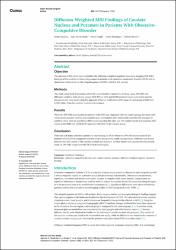Diffusion-weighted MRI findings of caudate nucleus and putamen in patients with obsessive-compulsive disorder
Citation
Aglamiş, S., Murat Aydın, A., Eroglu, Y., Burakgazi, G., & Atmaca, M. (2021). Diffusion-Weighted MRI Findings of Caudate Nucleus and Putamen in Patients With Obsessive-Compulsive Disorder. Cureus, 13(8), e17023. https://doi.org/10.7759/cureus.17023Abstract
Objective
The purpose of this study was to establish the diffusion-weighted magnetic resonance imaging (DW-MRI) findings of the caudate nucleus and putamen in patients with obsessive-compulsive disorder (OCD) and to obtain new information on the etiopathogenesis of OCD, which is still unclear.
Methods
The study comprised 20 patients with OCDs and 20 healthy volunteers. In these cases, DW-MRI and diffusion-weighted echo-planar images (DW-EPI) at b600 and b1000 gradient values were taken and the measurements were made using the apparent diffusion coefficient (ADC) maps of each group at b600 and b1000 values from the caudate nucleus and putamen.
Results
When the DW-MRI examination in patients with OCD was compared with the control group, the mean ADC values in the caudate nucleus and putamen were not found to have statistically significantly changed. In addition, there were no significant differences regarding the right and left caudate nuclei and putamen ADC values at the b600 and b1000 in the patients with OCD or the control group.
Conclusion
There are still many unknowns about the neurobiology of OCD. When the DW-MRI examination of the patients with OCD was compared with the control group in our study, no significant difference was found between the ADC values of the caudate nucleus and putamen. Further studies are required for this present study on DW-MRI in patients with OCD to be meaningful.


















